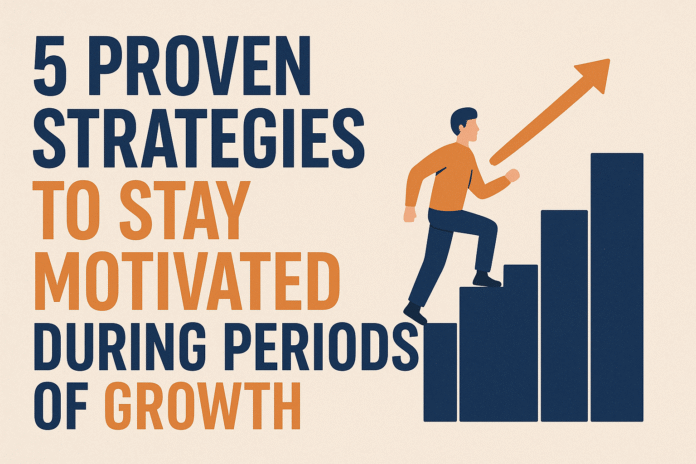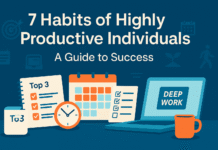Growth is exciting — new opportunities, bigger goals, fresh responsibilities. But growth also tests your motivation: what fired you up yesterday may feel shaky when expectations rise, systems change, or fatigue creeps in. This article shows how to keep motivation steady and sustainable while you grow. You’ll get five practical strategies, step-by-step implementation plans, scaling options, safety and common mistakes, quick-checklists, a 4-week starter roadmap, FAQs, and evidence-backed references so you can act confidently and measure results.
This piece is written for anyone navigating a growth phase: individual contributors taking on larger roles, founders scaling a company, teams expanding their scope, creators ramping up output, and professionals stepping into new responsibilities. Throughout, the focus is on actionable routines and systems you can start today — even if you’re busy.
Key takeaways
- Build motivation on systems, not willpower. Sustainable drive comes from aligned goals, predictable habits, social support, and feedback loops.
- Use small wins and clear metrics to keep momentum during periods of rapid change.
- Protect your energy and guard against burnout with boundaries, recovery practices, and realistic pacing.
- Design your environment so desired actions become the easiest choices.
- Combine mindset practices with behavior design and measurable goals for the highest probability of long-term motivation.
Strategy 1 — Clarify Purpose and Stretch Goals (Direction + Challenge)
What it is and core benefits
Clarifying purpose means defining the why behind what you’re doing — the long-term aim or impact that makes daily tasks meaningful. Stretch goals are ambitious, specific objectives that push you beyond current performance while remaining attainable with effort.
Benefits:
- Aligns daily effort with larger meaning (deepens intrinsic motivation).
- Focuses limited attention and resources on highest-impact tasks.
- Stretch goals produce higher engagement because they combine challenge with direction.
Requirements / prerequisites and low-cost alternatives
Prerequisites: time to reflect; a quiet place to draft purpose statements and goals; a simple tracking tool (notebook, spreadsheet, or habit/goal app).
Low-cost alternatives: use a notebook and calendar instead of paid apps; run a 30-minute purpose clarity exercise alone or with a trusted friend.
Step-by-step instructions (beginner-friendly)
- Draft a 2-sentence purpose statement: answer “Why does this growth matter?” and “What will success look like in one year?”
- Set one stretch outcome for the next 6–12 months. Make it specific and measurable (e.g., revenue, users, product launch, skill level).
- Break the stretch into 3–5 intermediate milestones spaced over the period.
- Write one sentence explaining how daily work connects to the milestone.
- Schedule a weekly 15-minute checkpoint to review progress and adjust.
Beginner modifications and progressions
- Simpler: Start with a single 90-day goal instead of a 6–12 month stretch.
- Progression: Once comfortable, layer in team or cross-functional goals and align individual tasks to team outcomes.
Recommended frequency / duration / metrics
- Purpose review: quarterly (15–30 minutes).
- Stretch goal review: monthly (30 minutes) + weekly quick checks (15 minutes).
- Metrics: one primary KPI (e.g., monthly recurring revenue, active users, client retention rate) and 2–3 leading indicators (e.g., weekly demos, outreach numbers).
Safety, caveats, and common mistakes
- Mistake: Setting vague or vanity goals (“grow faster”) without clear measurement.
- Caveat: Overambitious stretch goals without resources lead to demoralization.
- Safety tip: Pair stretch goals with contingency checkpoints to reduce risk of burnout.
Mini sample plan (2–3 steps)
- Write a 2-sentence purpose and one 6-month stretch goal in 30 minutes.
- Break goal into three 8-week milestones and add a weekly 15-minute review to your calendar.
Strategy 2 — Design Small, Habit-Based Systems (Behavioral Momentum)
What it is and core benefits
This strategy turns motivation into predictable action by designing tiny, repeatable habits that compound. Instead of relying on episodic motivation to complete big tasks, you create small behaviors that are easy to do and stack into bigger outcomes.
Benefits:
- Makes action automatic and less dependent on fluctuating motivation.
- Reduces decision fatigue and procrastination.
- Produces consistent progress that builds confidence.
Requirements / prerequisites and low-cost alternatives
Prerequisites: a short list of target behaviors; access to cues (a time of day, an existing routine, or a physical prompt). No expensive tools required.
Low-cost alternatives: anchor new behavior to an existing habit (e.g., after brushing teeth, do one 2-minute planning task).
Step-by-step instructions (beginner-friendly)
- Choose one high-leverage habit you want to form (5–10 minutes of focused work, daily review, short outreach).
- Shrink it: make the habit so small you can do it in 30–120 seconds.
- Pick a reliable cue (morning coffee, calendar reminder, end of meeting).
- Do the tiny behavior immediately after the cue for at least 2 weeks.
- Celebrate instantly (a small mental acknowledgement) to reinforce the loop.
- Gradually expand the behavior after it becomes consistent (increase time or complexity).
Beginner modifications and progressions
- Simpler: One tiny habit per week.
- Progression: Move from tiny actions to compound routines (habit stacks) and timed work sprints.
Recommended frequency / duration / metrics
- Frequency: daily.
- Duration: start with 2 weeks to create consistency; aim for 21–90 days to stabilize habit.
- Metrics: streak length, completion rate (days completed ÷ days planned), and time-on-task for scaled versions.
Safety, caveats, and common mistakes
- Mistake: Trying to do too much at once (habit overload).
- Caveat: Habits need consistent cues and context to stick.
- Safety tip: If stress or workload spikes, keep the habit tiny to maintain the streak.
Mini sample plan (2–3 steps)
- After your morning cup of coffee, write two bullets in your work notebook listing the day’s top two priorities (30–60 seconds).
- After two weeks, expand to a 10-minute focused planning block.
Strategy 3 — Build Reliable Feedback Loops (Measurement + Celebration)
What it is and core benefits
Feedback loops are systems that give you frequent, honest information about progress and outcomes. They include quantitative KPIs, qualitative check-ins, and planned reflection. When feedback is timely and focused, it fuels motivation by showing real forward motion and informing course corrections.
Benefits:
- Maintains clarity and urgency.
- Reinforces behavior with evidence of progress.
- Helps identify early problems so you can adapt.
Requirements / prerequisites and low-cost alternatives
Prerequisites: at least one measurable indicator linked to your stretch goal; a place to capture results (spreadsheet, dashboard, or notebook).
Low-cost alternatives: use a weekly spreadsheet or a simple shared document to record key numbers and short reflections.
Step-by-step instructions (beginner-friendly)
- Select 1 primary KPI and 1–2 leading indicators.
- Decide on cadence: daily micro-metrics (if relevant), weekly reviews, and monthly evaluations.
- Create a simple tracker (one row per week with KPI, leading indicators, and one short note).
- Set a ritual: 10 minutes every Friday to update metrics and note one win and one lesson.
- Celebrate small wins publicly or privately to reinforce behavior.
Beginner modifications and progressions
- Simpler: Track one number weekly and write one reflection sentence.
- Progression: Build a dashboard or automated report for real-time feedback.
Recommended frequency / duration / metrics
- Daily micro-metrics for high-velocity projects.
- Weekly captures for most individual goals.
- Monthly strategic reviews.
- Metrics: primary KPI (outcome), 1–2 leading indicators (activities driving the outcome), qualitative satisfaction/energy score.
Safety, caveats, and common mistakes
- Mistake: Using too many metrics — this dilutes attention.
- Caveat: Metrics can be gamed; complement numbers with qualitative insight.
- Safety tip: If the metric starts causing harmful behavior (e.g., unhealthy overwork), pause and reframe.
Mini sample plan (2–3 steps)
- Choose one KPI and one leading indicator; create a weekly row in a spreadsheet.
- Every Friday, update the row, write one sentence about what helped or blocked progress, then mark one win.
Strategy 4 — Optimize Environment and Social Support (Ease + Connection)
What it is and core benefits
This strategy reduces friction for desired behaviors by altering your physical and digital environment and by intentionally engaging supportive people. Motivation is amplified when the environment nudges action and social ties reinforce identity and accountability.
Benefits:
- Decreases reliance on willpower.
- Social reinforcement increases accountability and enjoyment.
- Environmental cues can trigger consistent behaviors automatically.
Requirements / prerequisites and low-cost alternatives
Prerequisites: permission to change your immediate workspace or routines; a list of people you can ask to support or hold you accountable.
Low-cost alternatives: rearrange your desk, set phone to “do not disturb” during focus periods, or ask a colleague for a weekly check-in.
Step-by-step instructions (beginner-friendly)
- Audit the environment: list three barriers and three helpers around your tasks (noise, notifications, disorganized files).
- Remove one barrier immediately (silence notifications for work hours, declutter a workspace).
- Add at least one helper (a visible checklist, a timer, or a dedicated focus playlist).
- Choose a social support action: pick one person for weekly check-ins or join a small peer group.
- Create a simple accountability ritual: a 10-minute shared weekly standup, a check-in message, or a public micro-commitment.
Beginner modifications and progressions
- Simpler: Start by turning off nonessential notifications for two hours per day.
- Progression: Form a weekly mastermind or hire a coach/mentor for recurring support.
Recommended frequency / duration / metrics
- Environmental changes: one-time setup with monthly tweaks.
- Social check-ins: weekly or biweekly.
- Metrics: number of interruptions per day, focused hours per week, accountability check-ins completed.
Safety, caveats, and common mistakes
- Mistake: Relying only on external accountability without internal buy-in.
- Caveat: Social pressure can backfire if it’s punitive; choose supportive people.
- Safety tip: If social accountability causes anxiety, opt for anonymous or low-stakes accountability systems.
Mini sample plan (2–3 steps)
- Declutter your workspace and set a daily 90-minute focus block with phone on airplane mode.
- Arrange a weekly 15-minute check-in with one peer to report one progress metric.
Strategy 5 — Protect Energy and Prevent Burnout (Pacing + Recovery)
What it is and core benefits
Sustained growth often pushes intensity higher. Protecting energy is about pacing work, scheduling recovery, and building resilience to avoid the motivation-draining effects of chronic stress and burnout.
Benefits:
- Keeps motivation stable over months and years.
- Reduces performance drops and long recovery periods.
- Improves clarity, creativity, and decision quality.
Requirements / prerequisites and low-cost alternatives
Prerequisites: ability to schedule downtime; willingness to set boundaries.
Low-cost alternatives: short daily rests, micro-breaks, and consistent sleep routines.
Step-by-step instructions (beginner-friendly)
- Track baseline energy and workload for one week (note energy dips and recovery needs).
- Set non-negotiable recovery blocks: sleep schedule, at least two 30-minute daily breaks, weekly longer downtime.
- Apply a pacing rule: e.g., 90 minutes of focused work followed by a 15–30 minute break, or 5:2 work rhythm (five days high focus, two days lower intensity).
- Create a sleep and nutrition plan that supports cognitive function (regular sleep schedule, moderate caffeine, hydration).
- Schedule a monthly reset: a half-day with no email, no pressure, and a short reflection session.
Beginner modifications and progressions
- Simpler: Start with a consistent bedtime and one 20-minute midday walk.
- Progression: Build formal recovery rituals (digital sabbath, weekend mini-retreats).
Recommended frequency / duration / metrics
- Sleep: nightly target (7–9 hours recommended for most adults).
- Focus cycles: 60–120 minutes work blocks with short breaks in between.
- Metrics: subjective energy score (1–10) recorded daily; weekly focus hours; frequency of recovery days.
Safety, caveats, and common mistakes
- Mistake: Treating rest as optional rather than strategic.
- Caveat: Productivity hacks without rest compound risk of burnout.
- Safety tip: Watch for chronic exhaustion, cynicism, or decreased efficacy; these are signs to reduce load and seek professional help if persistent.
Mini sample plan (2–3 steps)
- Commit to 8 hours of sleep and a daily 90-minute morning focus block for two weeks.
- Add a 15-minute midday walk as a non-negotiable recovery break.
Practical Add-Ons
Quick-start checklist (warm-up for sustained motivation)
- Write your two-sentence purpose and one stretch goal (10–20 minutes).
- Pick one tiny habit to start today and anchor it to a current routine.
- Create a single row in a tracker for your most important metric.
- Remove one environmental friction (notifications, clutter).
- Schedule weekly 15-minute reviews and a non-negotiable recovery block.
Troubleshooting / common pitfalls and fixes
- “I start strong, then fizzle.” Fix: shrink the habit size and focus on consistency over intensity.
- “Metrics feel meaningless.” Fix: replace or reduce metrics; add a qualitative insight (what you learned).
- “I feel guilty resting.” Fix: treat recovery as part of your productivity system; schedule it like any task.
- “My environment is chaotic.” Fix: pick one friction to remove each week; small wins compound.
- “Social accountability backfires.” Fix: change the tone of check-ins to supportive learning rather than judgment.
How to measure progress or results (simple framework)
- Outcome metric (one primary KPI).
- Leading indicators (2–3 activity metrics driving the outcome).
- Process adherence (habit completion rate).
- Energy and satisfaction (daily or weekly self-rating).
Combine these into a weekly snapshot: KPI, two leading indicators, habit streak, and energy score.
Simple 4-week starter plan (roadmap)
Goal: Launch a growth project while keeping motivation steady.
Week 1 — Clarify and Start Tiny
- Day 1: Write purpose + 6-month stretch goal.
- Days 2–7: Choose one tiny habit; perform it daily and anchor it to an existing routine.
- End of week: Create a single row tracker for your KPI and a weekly 15-minute review slot.
Week 2 — Build Momentum
- Continue tiny habit daily.
- Start weekly Friday 10-15 minute metric update: KPI snapshot + one note.
- Implement one environmental change (e.g., block 2 hours for focus).
Week 3 — Add Social Support and Feedback
- Invite one colleague or friend for a weekly check-in.
- Increase tiny habit slightly (e.g., from 2 minutes to 10 minutes) if the streak is solid.
- Evaluate energy and adjust pacing (add a short recovery ritual if energy dips).
Week 4 — Review & Scale
- Conduct a monthly review: KPI change, leading indicators, habit consistency, energy trend.
- Celebrate one meaningful win publicly or privately.
- Decide one safe scale action for Month 2 (add a new tiny habit, increase accountability frequency, or set a new milestone).
Frequently Asked Questions (8–12)
1. How quickly will these strategies improve my motivation?
You can expect to feel a small boost within days from habit small wins. Substantial and sustainable improvement typically takes several weeks to months as systems stabilize.
2. Can I use these methods while working full-time or running a company?
Yes. The approach emphasizes tiny habits and low-friction systems designed to fit into busy schedules.
3. What if I fail to meet my stretch goals?
Treat shortfalls as learning data. Reassess the goal’s realism, resources, and time horizon, then iterate. Avoid punishment; focus on course correction.
4. How many metrics should I track?
Keep it minimal: one primary outcome KPI, two leading indicators, habit adherence, and a simple energy score. More metrics dilute focus.
5. Are social accountability groups necessary?
They’re highly helpful but not required. If social pressure causes stress, choose low-stakes or anonymous accountability.
6. How do I avoid burnout while pushing hard to grow?
Schedule recovery, monitor energy, maintain boundaries, and use pacing rules (e.g., work cycles with breaks). Take early action when fatigue signals appear.
7. What if I lose interest in my purpose statement?
Revisit and refine your purpose regularly. Growth often shifts priorities; adapt the statement to match current values and circumstances.
8. How do I measure “small wins” effectively?
Use a short checklist, a streak counter, or weekly notes. A single number (days completed) plus one qualitative sentence is enough to capture wins.
9. Should I prioritize mindset work or behavior design?
Both. Mindset fuels persistence; behavior design makes action easy. Start with behavior design to create momentum, and layer in mindset practices.
10. When should I seek professional help for motivation issues?
If persistent low motivation accompanies chronic exhaustion, hopelessness, or impaired daily functioning, consult a qualified professional.
Conclusion
Growth is a marathon of incremental choices, not a sprint of willpower. When you combine clear purpose, tiny habits, timely feedback, an optimized environment, and deliberate recovery, motivation becomes a dependable resource — not a mood that comes and goes. Start with one small change today, keep it simple, and build systems that let momentum compound.
Ready to start? Pick one tiny habit from this article and do it today.
References
- Self-Determination Theory (theory overview) — Self-Determination Theory website, last updated page. https://selfdeterminationtheory.org/theory/
- Carol Dweck: A Summary of Growth and Fixed Mindsets — Farnam Street (fs.blog), April 2015. https://fs.blog/carol-dweck-mindset/
- Locke and Latham’s Goal Setting Theory: Set Better Goals — World of Work / people-shift article, July 8, 2019. https://people-shift.com/articles/locke-lathams-goal-setting-theory/
- Atomic Habits: Habits Guide (how to build good habits and break bad ones) — James Clear (habits guide page), undated resource page. https://jamesclear.com/habits
- Atomic Habits Summary — James Clear (summary page), undated. https://jamesclear.com/atomic-habits-summary
- Tiny Habits (official site) — Tiny Habits / BJ Fogg, undated resource page. https://tinyhabits.com/
- Fogg Behavior Model — B=MAP — BehaviorModel.org (overview of the Fogg Behavior Model), undated. https://www.behaviormodel.org/
- Burn-out is defined in the International Classification of Diseases (ICD-11) — World Health Organization news release, May 28, 2019. https://www.who.int/news/item/28-05-2019-burn-out-an-occupational-phenomenon-international-classification-of-diseases
- State of the Global Workplace Report (employee engagement trends) — Gallup (state of the global workplace overview), 2024 report page. https://www.gallup.com/workplace/349484/state-of-the-global-workplace.aspx
- New Workplace, U.S. Employee Engagement Stagnates (engagement data) — Gallup (U.S. employee engagement overview), 2023/2024 reporting. https://www.gallup.com/workplace/608675/new-workplace-employee-engagement-stagnates.aspx
- SMART & SMARTER KPIs Explained (SMART goals overview) — SimpleKPI.com blog, recent explainer (2024/2025 timeframe). https://www.simplekpi.com/Blog/smart-and-smarter-kpis-explained
- Self-Determination Theory explained (practical summary) — PositivePsychology.com (overview article), undated summary resource. https://positivepsychology.com/self-determination-theory/
- Tiny Habits: Free Resources page — TinyHabits.com free toolkit and resources, undated. https://tinyhabits.com/free/




































